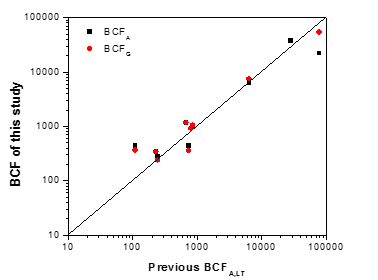Bioaccumulation is one of the key criteria (PBT - persistent, bioaccumulative and toxic) that used to do the chemical risk assessment, with bioconcentration factor (BCF) as the practical metric. However, it is challenging to measure the in vivo BCF,and it is even more challenging when comes to mixture since the current standard method – OECD TG 305 is designed for measuring BCF of single chemical. But many products that required to be registered/evaluated according to regulations are mixture such as essential oils that used as personal care products.

Figure 1. Comparison of the abbreviated in vivo BCF method with standard method OECD guideline 305.
To address this challenge, Dr. Chang-Er Chen and co-workers recently proposed an abbreviated BCF measurement methodology (ABCF) with a single dietary exposure and internal benchmarking method. They firstly developed an analytical method for determining the volatile fragrance ingredients in fish, and then developed the ABCF method with mixture of model chemicals. With this method, the kinetic BCF can be derived by only measuring the overall depuration rate constant (kT) without the need of knowing the water concentration (Cw). This method can reduce the the length of the in vivo experiment and the number of fish used. The results showed that this ABCF method can derive comparable BCFs to the OCED TG 305 protocol.
This ABCF method is promising for estimating the BCFs of real mixtures such as the natural complex substances (essential oil as one example). One application of this method to pine oil with rainbow trout has been conducted, data analysis is undergoing. This method will benefit the current PBT assessment and has attracted extensive attentions from many stakeholders such as industries (e.g. Unilever, P&G, Shell, etc), academia and regulators (e.g. Swidish Chemical agency, ECHA, USEPA, Environment Canada, etc).